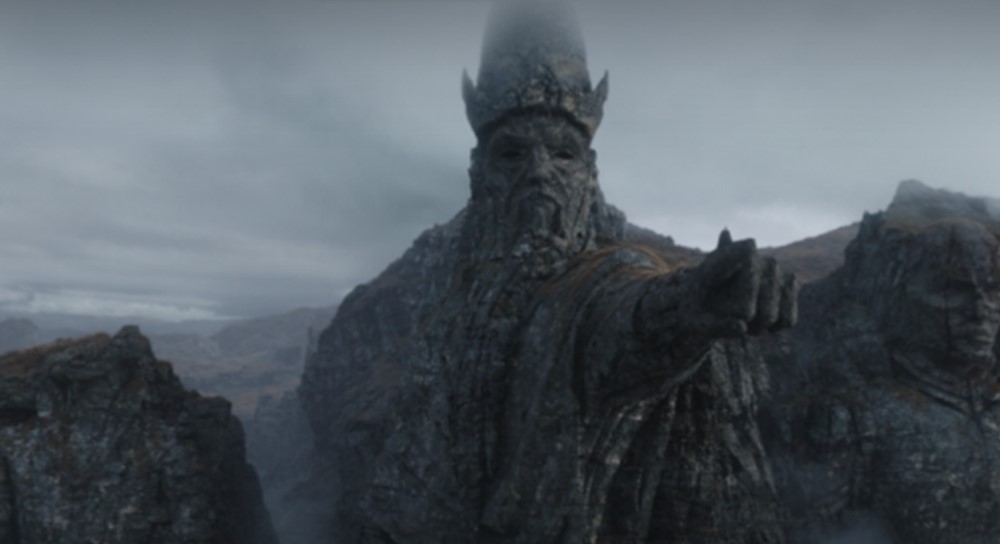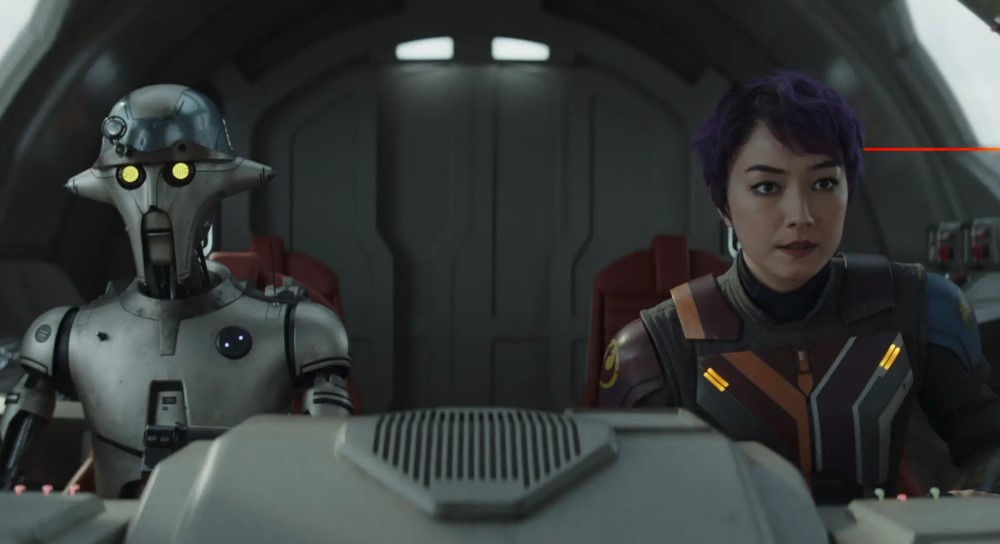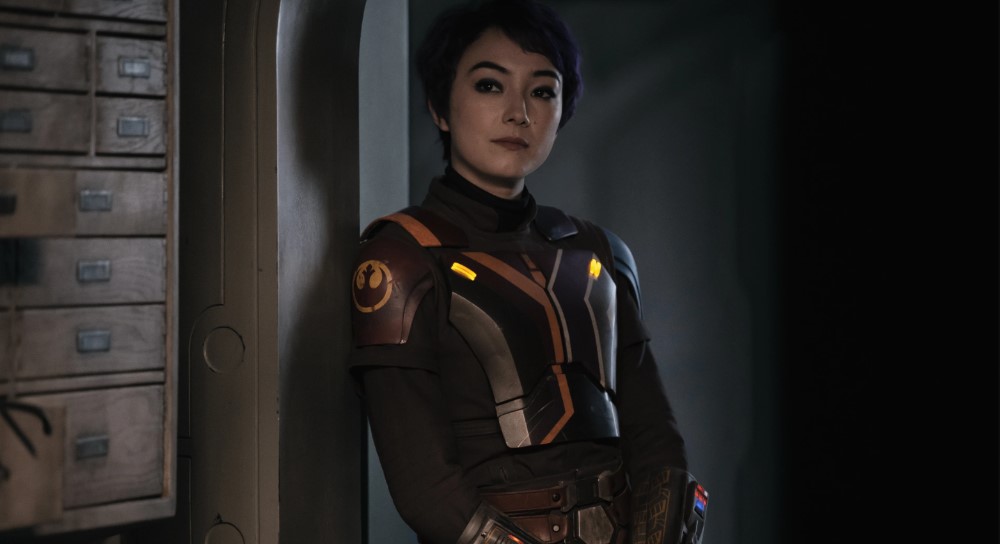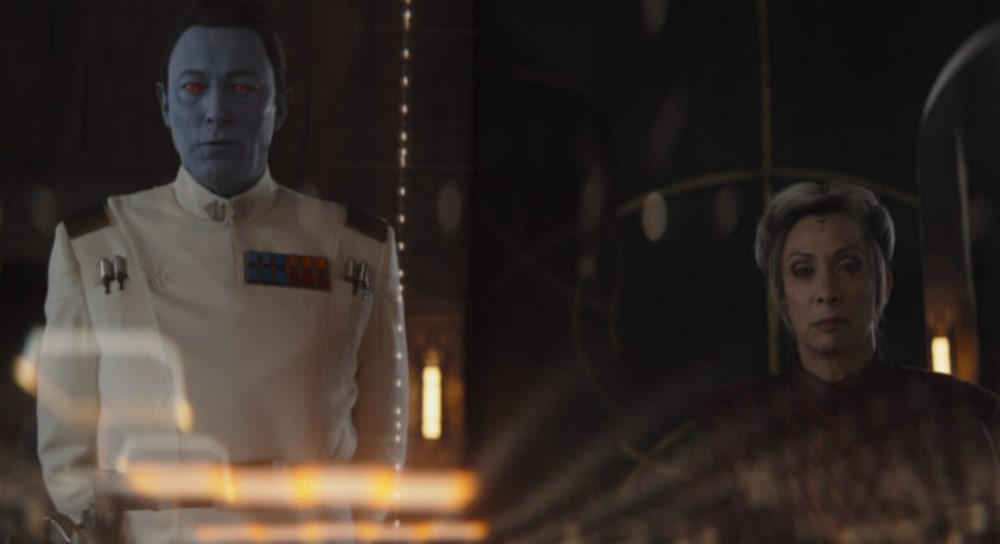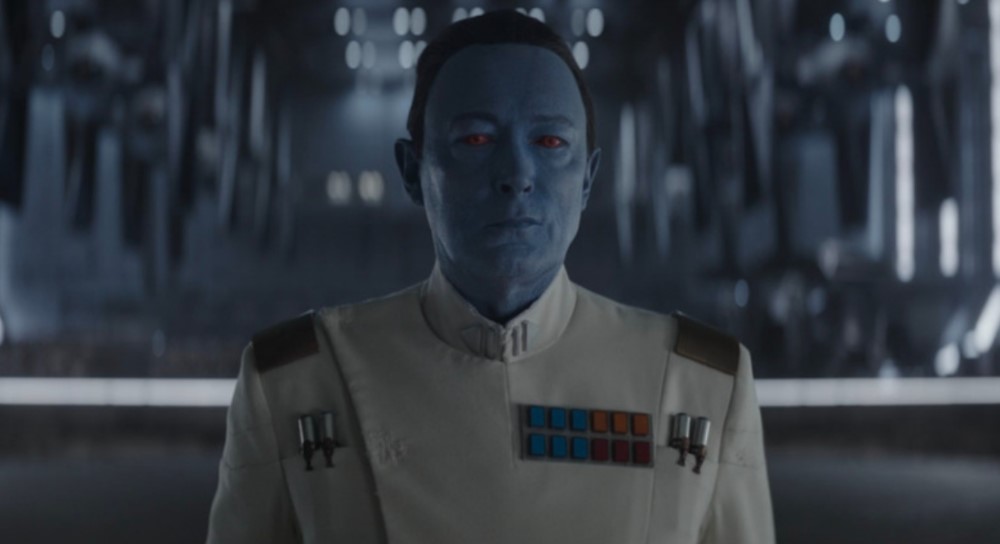Every time an episode of Ahsoka lands, Fantha Tracks will be giving their responses, and here are our initial gut feelings, deep dives and thoughts on the eighth and final episode of season one, ‘The Jedi, The Witch and The Warlord’. Beware of spoilerific elements in here.
“Ezra is where he needs to be. And so are we.”
Some fans may not agree but Ahsoka Tano is confident and at peace as she shares these sentiments with Sabine Wren at the end of Part 8, the season finale, of the inaugural season of Ahsoka. Most characters, protagonist and antagonist alike, have navigated their way to, or through, their intended goals from the season’s start. A quick recap:
Thrawn and the Great Mothers, with the mysterious bounty in tow, have escaped to their original galaxy and are headed to Dathomir. Ezra Bridger, a stowaway aboard Thrawn’s ship, the Chimaera, apparently slipped away and returned to Hera Syndulla, Chopper, and their frustrated faction of the “good guys” within the New Republic. Morgan Elsbeth rescued Thrawn from exile and became a more powerful witch, accepting the gift of the shadows, only to become the next of the unforgiving Chiss’ sacrificial lambs. Shin Hati is forging her own path—is leading a tribe of nomads on Peridea power enough for her? Her former Master, Baylan Skoll, has seemingly found what he was searching for as he sits upon the massive statue palm of The Father from the Mortis Arc of The Clone Wars. It takes on extra gravity when Morai, the convor associated with The Daughter, appears again near Ahsoka. The fables, myths, and children’s tales mocked by Seator Xiono are exactly what Baylan was hoping for on Peridea—and just maybe Ahsoka is realizing that too. And where do these events take us next? Some irresponsible speculation of mine:
Regardless of how or when, or if it’s actually planned for audiences to consume it on Disney+, the potential next stage of Mortis becomes fascinating. Are Baylan, Ahsoka, Sabine, and Shin indeed on Mortis—the place defined by the animated Force ghost of Qui Gon Jinn as, “a conduit through which the entire Force of the universe flows?” This would make sense as the beginning Baylan seeks, but he also doesn’t realize Ahsoka has the life force of The Daughter imbued within her.
And since I’m already speculating, I’m going to throw this out there as well: Lor San Tekka, primarily known for his short-lived appearance at the beginning of The Force Awakens, is an explorer and parishioner of the Church of the Force. His family rose to prominence prior to the High Republic as prospectors of the hyperspace lanes. As a confidant and traveling partner of Luke Skywalker, post Return of the Jedi, could it be Lor who navigates the way to rescue Ahsoka and Sabine—and maybe that journey is what sends him to the church?
In his words to Poe Dameron, prior to being killed by Kylo Ren, Lor says, “I have traveled too far and seen too much to ignore the despair of the galaxy. Without the Jedi, there can be no balance in the Force.” This is just another random fan theory but what if he navigates the way to Peridea/Mortis and has experiences so wondrous, torturous, and unbelievable that his faith is reinforced and elevated?
Regardless of what comes next, I loved this season of Ahsoka. Rest In Peace, Ray Stevenson.
The season finale of Ahsoka is mostly one continuous action sequence, and I am totally here for it. The first fight scene involves an air strike on our heroes, which continues in the recent Star Wars tradition of emphasizing the lethality of individual TIE fighters. Temporarily without a functioning ship, Ahsoka Tano, Sabine Wren, and Ezra Bridger storm the Dathomiri fortress on howlers while under fire from Thrawn’s Star Destroyer. The trio make it through the gates through their collective Force powers. Judging by the sound effects, this definitely includes Sabine. Once indoors, they are immediately under fire from night troopers. Our heroes make quick work of them but soon the troopers are all on their feet again, reanimated by the Nightsisters’ dark magick. They are now a far greater nuisance, adhering to the rules of traditional zombies by requiring severe head injuries to put down. Morgan Elsbeth gets told to stay behind at what she expects to be her moment of triumph, and with the help of her newly acquired Blade of Talzin (and maybe also some anger) puts up a spectacular fight against Ahsoka. Sabine and Ezra continue to advance, but are stopped by two death troopers who literally “live” up to their name. How long have they been kept around in that state? During this fight, Sabine fully harnesses the Force while Ezra seemingly forgets to use it until after she does. After the two zombies are defeated, she promptly uses her new powers to help boost Ezra onto the Chimaera. She is supposed to follow but stays behind to help Ahsoka instead, who defeats Morgan shortly after. But they are too late. Thrawn takes off on his hyperdrive ring-assisted Star Destroyer, unwittingly sending Ezra home in the process. Aside from Hera, the main characters of the show have now all traded places and we still don’t know who’s been in the catacombs.
Just like the witch was killed by the lion in C. S. Lewis’s story, Morgan is killed by a (the?) Jedi at the end of season one. Did she have any idea what she was getting into? The turning point appears to occur in the opening scene when she is offered the gift of shadows as a “reward”, which appears to catch her off guard and leaves her visibly uneasy. The ritual almost sounds like a wedding ceremony but instead of a groom there is witchcraft, and a magical sword in lieu of a ring. Was it the intention of Thrawn, and possibly even the Nightsisters, to leave her behind? Or were they simply more than prepared to? Only one of the Great Mothers show any remote semblance of concern for Morgan. Was the Blade of Talzin given to her specifically to stall the Jedi? Is the blade made of beskar, or is it the wielder’s witchcraft that blocks lightsaber blades? It was a nice touch that it becomes a normal-looking sword again once held by Ahsoka.
Some thoughts about the other two Jedi: I continue to be a fan of live action Ezra. From what I can remember (and it’s admittedly not much), he seems to be most similar to his animated counterpart. It’s all in the details, such as his nervous smile after stabbing the zombie death trooper failed to produce desired results and the way he says “Hi Hera, I’m home” at the end. Clever horizontal wipe to Sabine: I’m not sure how I feel about her suddenly becoming an outright force user. It seemed slightly out of the blue, having mainly associated her with being a Mandalorian for so long prior to this show. Maybe it would have seemed less abrupt if she was seen using the Force in more obvious ways earlier on in the series although to be fair, plenty of hints were dropped. When Sabine leaves the room after Huyang declares Ezra to be a good student, does she do so out of anger? It looks like some of Yoda’s teachings have successfully reached her, which is a nice touch. As a side note, it’s interesting how late bloomer Jedi have different ideas of what it means to be one during their early days of training. As padawans, both Anakin and Luke associated being a Jedi with saving others, Rey will go on to equate it with lifting rocks, and Sabine (perhaps being a Mandalorian) thinks primarily in terms of lightsaber mastery.
At the start of the season, Baylan Skoll and Shin Hati were arguably the most intriguing characters of the show. Their intentions are murky, lightsabers glow a sinister orange, and their attire is unlike any I’ve seen in Star Wars, giving them almost a medieval look. I had hoped and expected to learn much more about them by the end of the season but both characters fade into the background towards the end in favor of setting up their future arcs. This is perhaps especially true of Shin who after refusing to surrender to Ahsoka, runs off and goes missing for the entire final showdown. Was she randomly meandering around that whole time, and why didn’t she go straight back to Thrawn? It was previously suggested by Baylan that she would take a position of power in Thrawn’s Empire, but she wound up with an apparently massive downgrade by joining the local bandits instead.
For the first time this season, I sat through the entire end credits. I did so in case there was an easter egg scene at the end (there wasn’t), but what I did see instead was an ILM Stagecraft credit. Immediately it dawned on me that I did not consciously think about the Volume a single time while watching Ahsoka, which is a testament to the progress they have made with what is still relatively new technology. Even as recently as season three of The Mandalorian, the usage of Stagecraft was still painfully obvious in certain scenes. To fully correct that by the very next show is quite a feat.
The overall season superficially reminded me of The Empire Strikes Back in a few ways. An established set of characters find themselves on the losing end of a conflict and one of them goes off on a somewhat misguided journey to rescue a friend, and winds up on the back foot as a result. The villains have the upper hand but the heroes retain a glimmer of hope, and we have no idea what will come next. I will admit that having so many characters switching places was unexpected and felt odd to me. It clearly serves as a cliffhanger, but it’s sort of an unsatisfying one (is there such a thing as a satisfying cliffhanger?). With so many characters left on Peridea, how will future stories pan out? Will Star Wars be taking place in more than one galaxy from now on? What are the ramifications of Mortis god statues existing on Peridea? With Ray Stevenson tragically gone too soon, the character of Baylan Skoll will either need to be recast or written out. Either outcome would be a great shame, which serves as a testament to his incredible performance in what should never have been his swansong role.
I made two assertions in my season opening review: The show has just the right blend of action, drama, and humor that I like best about Star Wars, and that it doesn’t seem to require too much prior Star Wars knowledge. I am pleased to report that the first has stayed consistent for the duration of the season, and as an old school Star Wars fan I can say without reservation that it was a joy to watch. However, the second gradually became less true as the episodes progressed. I can’t imagine how confusing it must be to stumble onto the show having only seen live action Star Wars, and possibly getting more and more bewildered by increasingly unfamiliar elements such as a World Between Worlds, space whales, witches, a blue-skinned Imperial who is supposed to be dangerous because other characters keep saying so, and zombie stormtroopers. While I personally don’t have a great feel for storytelling and pacing, I have heard compelling complaints in these areas from folks way more knowledgeable than me. Nonetheless, the Ahsoka series felt solid in all the ways that matter most to me. Perhaps its greatest triumph is recapturing the early feel of Star Wars that made the franchise so successful in the first place. It may not be categorically the best Star Wars live action show, but it’s definitely in a league of its own.
This is last time we will ever see actor Ray Stevenson play Baylan Skol, and it wasn’t enough.
The most consistent criticism the Ahsoka Season 1 Finale has received is that two new, complex, and intriguing characters, Baylan Skoll and his apprentice, Shin Hati, barely get any screen time. What’s more we don’t even get a hint of what Baylan could be searching for, going on little more than oblique references to Jedi temple fairytales in past episodes.
The trend in Disney+ series, presumably to keep production costs down or allow for a higher budget per episode, has been shorter seasons. Each season of The Mandalorian has been 8 episodes, The Book of Boba Fett was 7, Obi-Wan Kenobi has the lowest number at 6, and Andor has the highest number at 12. I think it’s no coincidence that the most acclaimed series on this list, which told a story viewers thought was complete and satisfying, has the most episodes.
For Star Wars in particular, the move to Disney+ has largely replaced feature films. In many ways, this creates pressure to tell a grand, cinematic story, worthy of a theatrical release, but in a serialized format for a smaller screen. I haven’t quite pinpointed what fallout or growing pains this has induced, but there’s definitely something happening in these series that is not quite television and not quite film. It’s a strange hybrid genre called a streaming series, upon which we cannot neatly map traditional notions of storytelling for television. So I’m not saying we have to revert to more of a network television model, with 22 or more episodes in a season, but it’s clear that for a story of the scope and scale of Ahsoka, we could have easily gotten value out of more than 8.
Baylan and Shin’s story remains suspended, presumably under the assumption that it will resume in a second season. I hope the creators behind the series can recast Ray Stevenson — as painful as that will be and as difficult as that will be for whoever steps into the role — so that we can see his story play out as originally intended, but that complication aside, I think the assumption this series operates under here is that it is telling a much bigger story than this one season and even this one series.
I have concern about this “Rebels, assemble!” approach to Star Wars storytelling. Only later will we really know if the Season 1 finale of Ahsoka makes more sense as a stepping stone towards a deep bench showdown against Thrawn on the big screen than it does as the endpoint of an isolated story arc. Out of all the reasons to leave plot lines like Baylan and Shin’s unresolved, though, the simplest one may prevail: this series is called Ahsoka and therefore should primarily focus on that titular character. Through the lens of Ahsoka’s arc this season, as a wayward ex-Jedi and apprentice to Anakin Skywalker, who, since fans last saw him in animation, became Darth Vader and ultimately died in Return of the Jedi, marking what is perhaps the greatest redemption arc in all of genre storytelling. Once I consider this finale through the lens of what’s going on with Ahsoka as a character and everything in her emotional orbit, this episode gave us a great deal of development and resolution.
This finale tells us that the story the season has been trying to tell all along is one of masters and apprentices, and, centrally, Ahsoka being Anakin’s apprentice and then struggling to take on an apprentice of her own, Sabine. When we begin the season, Ahsoka and Sabine are estranged, and as the season progresses, Ahsoka faces her guilt and fear about Anakin and his lasting legacy as Darth Vader in order to become a better master to Sabine. She moves from cold rigidity in Part 1 to warm acceptance in Part 8. She may not have made the same choice as Sabine, but she recognizes that to be a good master, she still needs to support Sabine’s choice and, rather than dwell on the consequences, becoming angry and frustrated, she must trust in the Force and deal with situations as they come.
Their conversation gave us all we needed to know to appreciate how far Ahsoka has come. Sabine asks, “You’re not mad?”, with surprise in her voice. Ahsoka replies with a moment of identification, trying to relate to Sabine’s experience: “Over the years, I’ve made my share of difficult choices. Often, no one understood my reasons.” Then her words turn to Anakin as she says, “Except my master…He always stood by me. Even when no one else did. That’s why no matter what happens next, I’m going to be here for you.” Ahsoka is only able to say this to Sabine because she has, over the course of the season, realized that the evil of Darth Vader does not erase the good of Anakin Skywalker. That he was still a “good master” who always supported her, and that it’s okay for her to pass down his teachings to Sabine, who may have, as we learn here, had her own dangerous brush with the Dark Side.
Here is the payoff of all the varied references to Anakin, including the World Between Worlds flashbacks from The Clone Wars and the training video Ahsoka watches on the shuttle. Most notably and vocally in this episode, Thrawn invokes Anakin Skywalker, both as a way of explaining his strategy (“There will be no negotiating with the apprentice of Anakin Skywalker”) and as a way to taunt Ahsoka (“How similar will you become?”). While he does get just enough of reaction out of Ahsoka to imply that she would relish in a rematch someday, I think that he ultimately fails in getting in her head because of all the healing that has come before this episode. I can see so many lines from the Anakin scenes in Part 5 coming to roost here, but, just as an example, Anakin says “soon you’ll be everything I am” and that she’s more than her war-torn past and more than his fall because, as he says, “You’re more than that. I’m more than that.” To me, the narrative through-line of this season couldn’t be clearer.
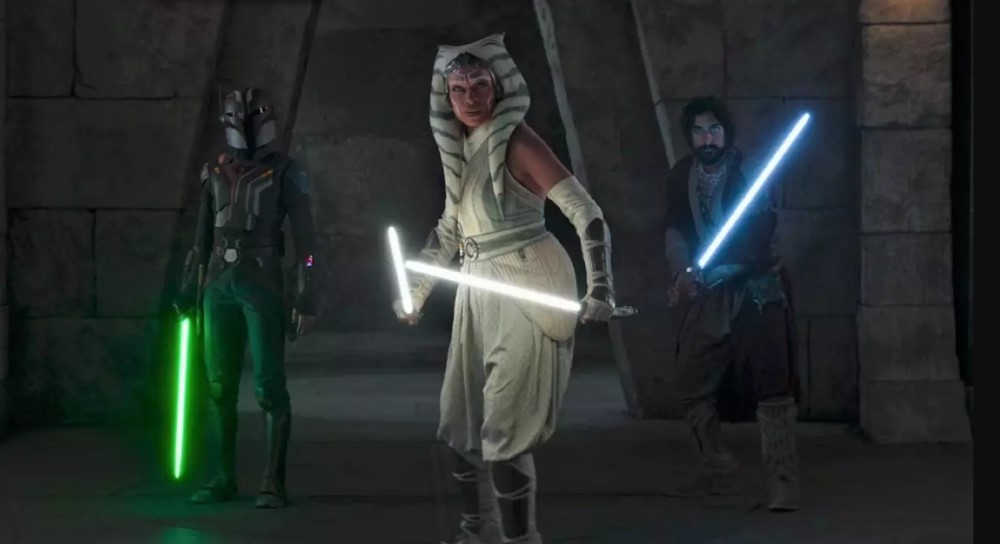 The thesis of this series stated more explicitly and more broadly, though, comes from Huyang. When Ezra asks him how old he is, the erudite yet sassy droid says, “Old enough to know that the relationship between a master and an apprentice is as challenging as it is meaningful.” Sabine and Ahsoka’s relationship may be challenging, but that doesn’t mean it can’t also be meaningful if they can work out their issues. We see that in action in this episode, in fact. Whereas they had trouble being on the same side and staying together, not listening to Huyang’s advice in Part 4, the end of this episode shows them getting it right this time: Ahsoka says she’ll always have Sabine’s back and tries to do everything she can to help get Ezra home, and Sabine, in turn, gives up the one thing she cared about most in the world — reuniting with Ezra — to stand by Ahsoka, knowingly stranding herself on Peridea.
The thesis of this series stated more explicitly and more broadly, though, comes from Huyang. When Ezra asks him how old he is, the erudite yet sassy droid says, “Old enough to know that the relationship between a master and an apprentice is as challenging as it is meaningful.” Sabine and Ahsoka’s relationship may be challenging, but that doesn’t mean it can’t also be meaningful if they can work out their issues. We see that in action in this episode, in fact. Whereas they had trouble being on the same side and staying together, not listening to Huyang’s advice in Part 4, the end of this episode shows them getting it right this time: Ahsoka says she’ll always have Sabine’s back and tries to do everything she can to help get Ezra home, and Sabine, in turn, gives up the one thing she cared about most in the world — reuniting with Ezra — to stand by Ahsoka, knowingly stranding herself on Peridea.
A good teacher cannot didactically hand down knowledge; they must meet their student where they are, take their identity and experience into account and let them actively participate in their own learning. It’s what would happen if Thrawn used his tactical powers for good — just in the way he must take who his opponent is into his strategy, so too must a teacher take into account who their student is and how their student best learns in order to effectively teach them.
We actually get many versions of this teacher and student relationship throughout the episode. Kanan and Ezra’s seems to be upheld as a sublime ideal; even long after his death, we can see Kanan’s positive influence on his apprentice, who ends up building a lightsaber with the only other copy of the part a young Caleb Dume (Kanan’s given name) used to make his. Huyang can really only help Ezra once he can use his knowledge of Kanan as context through which to understand Ezra’s “method.” And, as I discussed earlier, Ahsoka and Anakin’s relationship may seem like a failure on paper, as she left the Order and he became Darth Vader, but this series has worked hard to establish that despite the way things turned out, their bond as student and teacher was pure.
In The Mandalorian, Ahsoka refers to Thrawn as Morgan Elsbeth’s “master”, and if we view their relationship as master and apprentice, it becomes clear that Thrawn, unsurprisingly, does not care about Morgan at all and is more than happy to sacrifice her, ordering her to duel Ahsoka as he skips off to another galaxy. That brings us back to Baylan and Shin. We see the final scenes of Baylan standing on the edge of the cliff, searching for some ancient power, and Shin raising her lightsaber to make her bid as the new leader of the Peridean marauders. Would the marauders, under Shin’s leadership, then rejoin Baylan to provide muscle to his new world order, or are they really doing their own thing? After such an ambiguous development in their relationship last episode, generating even more open questions with where they leave off this week would be understandably frustrating for many. There’s a difference between leaving us in suspense and leaving us in a state of confusion.
At the start of this review, I said that the final scene of Baylan was not enough. This is not entirely true for viewers who have seen the Mortis arc of The Clone Wars animated series. The ruins we see behind Baylan are ancient Force beings or “Mortis gods” called The Father, The Son, and The Daughter. The Father’s role was to keep The Son, who skewed towards the Dark Side, and The Daughter, who skewed toward the Light Side, in balance. The implication was, at least for me, that this balance somehow affected the balance in the Force in the wider galaxy. I don’t think it’s a coincidence that the most wrecked statue, missing a head, is The Daughter on the left; she died and transferred her life essence, force, spirit, etc. to a young Ahsoka. This could very well have made Ahsoka’s destiny to restore balance to The Force in the most fundamental, deeply mythological way.
Now that the Mortis gods are on the table, and now that Ahsoka’s convor guardian Morai is FINALLY HERE, I am downright giddy about the possibilities for the role Ahsoka might play in Baylan’s quest on Peridea and what he might learn about her and the nature of the Force in the process. I honestly thought this was too deep a cut for a series like this, and I couldn’t be happier that Dave Filoni was bold enough to incorporate this high concept, borderline esoteric mythology into a live action series.
I think the response to Baylan and Shin and their marginalization in this finale is a testament to a thirst for new characters in new stories as much as, perhaps more so, than characters with which we are already familiar. These are two characters whose histories are still shrouded in mystery. We know Baylan trained at the Jedi temple and was a General in the Clone Wars, but we do not yet know exactly what happened to him there and then. We don’t yet know how he met Shin. We don’t know even where Shin came from, and with a series that increasingly requires prior knowledge or at least rewards those with prior knowledge of previously introduced characters, a lot of the interest of viewers coming in from the outside will gravitate towards characters who are new to everyone.
I do not want anyone to mistake my critique of the Ahsoka finale as a reflection of my attitude towards the series as a whole. I have cherished all the time we’ve spent with Ahsoka and other characters I love, and I am extremely excited for how Dave Filoni continues to ground his storytelling in what makes Star Wars Star Wars while also breaking new ground and pushing the franchise forward. If writing these reviews every week has taught me anything, it’s that Dave Filoni has grown beyond his own master, George Lucas, by bringing his fantasy world building sensibilities — inspired by J.R.R. Tolkien, C.S. Lewis, and Hayao Miyazaki — to a galaxy far, far away.
No, make that TWO galaxies, far, far away.
(This is condensed and edited – with permission – from Jen’s The Long Take review, which you can subscribe to here)
Sander de Lange looks at all the reveals and easter eggs in Ahsoka – The Guide Part 8: The Jedi, The Witch and The Warlord.
Brian Cameron and Mark Newbold discuss The Jedi, The Witch and The Warlord on Good Morning Tatooine.
Mark Mulcaster and Mark Newbold discuss Part 8 on Making Tracks Reaction Chat: Ahsoka S1E8 – The Jedi, The Witch and The Warlord.
- Hardcover Book
- Fujikawa, Jenn (Author)
- English (Publication Language)
- 208 Pages - 10/10/2023 (Publication Date) - Insight Editions (Publisher)


